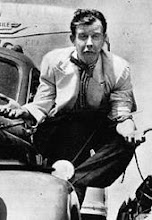Well maybe rest in peace is a bit much.
One of my favorite overdrive pedals, the
Klon Centaur, is no longer being made. As of December 22 of last year, the production of the Klon ceased, presumably to allow full time devotion to the R& D of the infamous pedal's successor. Below, the first version of the Klon featuring a gold finish and red centaur logo:
The Klon Centaur Overdrive is a hand made guitar effect pedal built one at a time by the inventor. It is a simple and sturdy unit with a unique look. Apparently the original unit has been discontinued in favor of a new version housed in a smaller chassis. The new Klon-Jr is slated for release sometime this year. No word on any mods to the circuit design. I stumbled upon the Klon years back thanks to a tip from
Jim Campilongo. Check out another
House of Twang post about him
here.
Smaller pedals are all well and good. There's nothing like conserving space on your pedal board, especially if you're one of those fellas whose uses a ton of different stomp boxes:
I love guitar effects. However, for the music I play, I rarely feel the need for anything more than a Fender amp's spring reverb and tremolo coupled with a good analog delay (I'm a big fan of the Maxon AD80) or even better: the lush tape delay tones of a
Fulltone TTE (Tube Tape Echo). So in this case I'm not to broken up over the idea of the Klon shrinking in size. I have to imagine the fella that makes the Klon will retain the stomp box's unique sound. It's hard to describe what the Klon does but in a nutshell, is gives your amp more of itself.
Mo' betta.
Using this pedal, you can get that wide open, cranked amplifier sound without having to turn your amp up to deafening volume levels. I employ the Klon when using a higher powered amp so I can get a nice overdriven tone without being too loud. When
Boss Tweed was touring Europe, I just used the Klon and my Maxon delay night to night. I was always able to dial in a sound that I liked no matter what the provided backline might have been. To my ears it is exceptionally transparent whereas many Tubescreamer-type pedals kill your guitar's natural tone with thin, mid-rangey overdrive. Not into crazy overdrive? Then back off the Klon's gain, add a pinch more volume and it's like putting a tone magnifying glass on your amp.
Mo' betta.
The Klon is a fairly mysterious beast. I say mysterious because the fella that makes these things pours some kind of black goop all over the circuit board inside the pedal in an effort to protect his design from would-be copy cats (below). Note the stamped out area for secure positioning of the 9 volt battery. Smart. Why aren't more effects built this way?
Like most guitars, amps and effect pedals, it's hard to understand what the Klon sounds like and how it interacts with your guitar rig without actually playing it. Problem is, the Klon is sold direct from the builder/inventor himself, so you can't just zip down to your local guitar shoppe and try one out.
Either you like it... or you don't.
A good saying for all guitar gear. Not everyone likes this pedal, of course. There are numerous haters out there and that's fine.
This guy goes on and on saying what a gimmick the Klon is while pimping his own overdrive pedal. Classy. To me, you're missing the point if you don't use the Klon with your live rig. It is made with the performing guitarist in mind, with amp dialed up to loud, not the bedroom picker forced to play at a tame volume.
For guitarists, the internet buzz over the Klon is heavy. For me, I'm happy to have scooped one up for cheap on eBay a few years back. Checking in on the 'Bay today, the same old Klon Centaur is fetching prices close to a grand! I'm sure there will be all sorts of speculation over whether the new version is as good as the old one. We'll see...
Either way, I'm proud to own one and consider it a sound investment... yuk yuk.
Below, the second version of the Klon which I use:
Guess we'll have to wait and see what the new version holds. I throw my support behind this pedal and its inventor. He has managed to carve out a niche in an over saturated market. Based on my experience with the Klon, I expect the new version to be as good if not better than its predecessor.


































